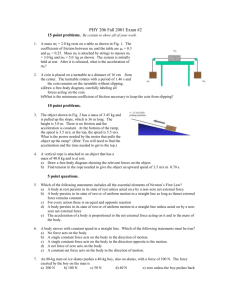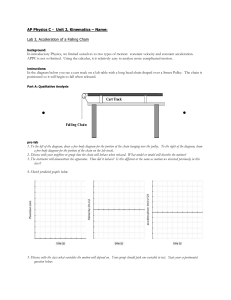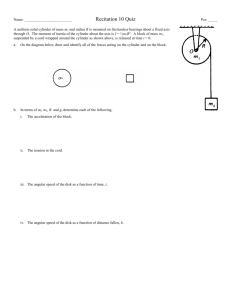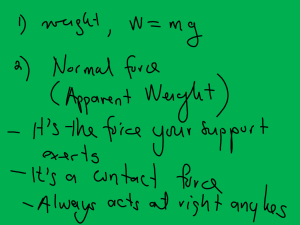Theory of Forces Adding Forces Review Forces and Motion Vector
advertisement
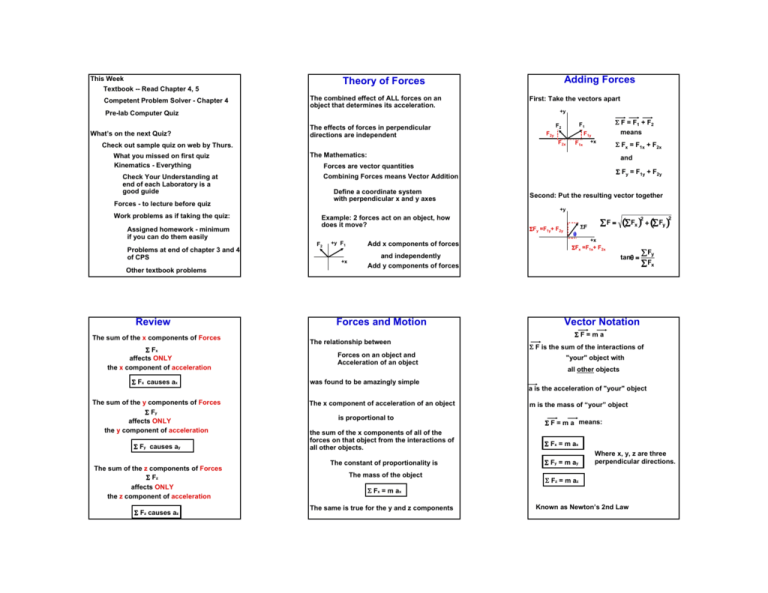
This Week Competent Problem Solver - Chapter 4 Adding Forces Theory of Forces Textbook -- Read Chapter 4, 5 The combined effect of ALL forces on an object that determines its acceleration. First: Take the vectors apart +y Pre-lab Computer Quiz What’s on the next Quiz? The effects of forces in perpendicular directions are independent What you missed on first quiz Kinematics - Everything Problems at end of chapter 3 and 4 of CPS Other textbook problems Review The sum of the x components of Forces Σ Fx affects ONLY the x component of acceleration Σ Fx causes ax The sum of the y components of Forces Σ Fy affects ONLY the y component of acceleration Σ Fy causes ay The sum of the z components of Forces Σ Fz affects ONLY the z component of acceleration Σ Fz causes az F1x +x Σ Fx = F1x + F2x and Forces are vector quantities Σ Fy = F1y + F2y Combining Forces means Vector Addition Define a coordinate system with perpendicular x and y axes Forces - to lecture before quiz Assigned homework - minimum if you can do them easily F1y The Mathematics: Check Your Understanding at end of each Laboratory is a good guide Work problems as if taking the quiz: F2y F2x Check out sample quiz on web by Thurs. Σ F = F1 + F2 means F1 F2 Second: Put the resulting vector together +y Example: 2 forces act on an object, how does it move? F2 +y F1 Add x components of forces +x and independently Add y components of forces Forces and Motion ΣFy =F1y+ F2y θ ∑F = ΣF (∑ Fx )2 + (∑ Fy ) 2 +x ΣFx =F1x+ F2x tanθ θ= ∑ Fy ∑ Fx Vector Notation ΣF=ma The relationship between Forces on an object and Acceleration of an object Σ F is the sum of the interactions of "your" object with all other objects was found to be amazingly simple a is the acceleration of "your" object The x component of acceleration of an object is proportional to the sum of the x components of all of the forces on that object from the interactions of all other objects. The constant of proportionality is The mass of the object m is the mass of “your” object Σ F = m a means: Σ Fx = m ax Σ Fy = m ay Where x, y, z are three perpendicular directions. Σ Fz = m az Σ Fx = m ax The same is true for the y and z components Known as Newton’s 2nd Law Is there always a force in the direction of the acceleration? Finding all of the forces and their values (a) Yes Simple case: A book on a table (b) No Step 1: Isolation Analyze the Forces If an object is accelerating Isolate the object you are interested in Draw only the forces on that object Only those forces determine its acceleration If no, give an example There appear to be 2 important objects here: F1 The book The table a m Draw all relevant forces. First Object: the book Free-body Diagram of Book Did you get them all? Only the forces on the book F2 Wb : gravitational pull of the Earth on the book (weight of the book) How do they combine? There is no “real” force in the direction of a How are they related? Wb Ntb Use diagrams to clarify Second Object: the table Third Object: the Earth Free-body Diagram of Table Free-body Diagram of Earth Ntb : contact push of the table on the book (perpendicular to the table/book contact) Relationship of Forces on a Single Object For the book: Σ Fy = m ay = 0 Nbt Wt : gravitational pull of the Earth on the table (weight of the table) WbE : gravitational pull of the book on the Earth NtE Ntb - Wb = 0 Wb Wt NEt Nbt : contact push of the book on the table (perpendicular to the book/ table contact) NEt : contact push of the ground on the table (perpendicular to the ground/table contact) WbE WtE WtE : gravitational pull of the table on the Earth NtE : contact push of the table on the ground (perpendicular to the ground/table contact) +y Ntb Ntb = Wb For the table: Nbt Σ Fy = m ay = 0 NEt = Wt + Nbt Wt For the Earth: NtE Contact pushes by a surface are usually called normal forces Normal is an old fashioned word for perpendicular One more relevant Object: the Earth NEt How are these forces related to each other? Σ Fy = m ay = 0 WbE WtE NtE = WbE + WtE Relationship of Forces on Interacting Objects A These forces are ALWAYS equal in magnitude and opposite in direction F2 B Newton’s 3rd Law Free-body Diagram of A Free-body Diagram of B A F1 B F2 Examples When a baseball player hits a ball with a bat There is ALWAYS a force on each object caused by the other object Object B pushes on Object A F1 Newton’s 3rd Law When any two objects interact These two forces are called 3rd Law Pairs 3rd Law Pairs ALWAYS The force of the bat on the ball is (a) larger than the force of the ball on the bat (b) smaller than the force of the ball on the bat (c) equal to the force of the ball on the bat When speeding car runs over a rat Act on DIFFERENT objects F1 is the contact push of object B on object A. F2 is the contact push of object A on object B. Are the SAME type of force Newton’s third law is true F1 and F2 are always equal in magnitude and opposite in direction. Whether or not the objects are accelerating F1 = - F2 Relationship of Forces on Different Objects For the book: Whether or not one object is much larger than the other Summary Ntb = Wb Wb Ntb Book and Earth For the table: Nbt Wb = WbE Wb Ntb For the table: PEt Table and Earth NtE NEt = NtE WbE WtE The weight of an object is the gravitational force on it exerted by a much larger object. Near the surface of the Earth that other object is the Earth How do you calculate that force? We will get to that at the end of this semester From Third Law NEt Ntb = Nbt Suppose you drop a book, the force on it is the Gravitational force of the Earth on the book Wb = WbE Wt = WtE Every force acting on your object has a third law pair that is a force on another object For now use Newton’s 2nd law and a thought experiment to find what this gravitational force equals For the Earth: For the Earth: WbE W tE NtE = WbE + WtE Wt Wt NtE NEt = Wt + Nbt Nbt (a) larger than the force of the rat on the car (b) smaller than the force of the rat on the car (c) equal to the force of the rat on the car Weight From Σ F = ma For the book: Book and table Ntb = Nbt The force of the car on the rat is Never show up on the same free body diagram Wt = WtE NEt = NtE Σ F = Wb The book accelerates with a value g Σ F = ma = mg Thus Wb = mg True for any object near the surface of the Earth Example FOCUS THE PROBLEM As might be stated in your text 20 kg 2.7 m/s2 TA A As it might appear on a quiz A 20 kg block rests on a frictionless table. A cord attached to the block extends horizontally to a pulley at the edge of the table. When another block of unknown mass is hung at the end of the cord after it passes over the pulley, the hanging block accelerates downward at 2.7 m/s2 and pulls the other block with it. Calculate the mass of the hanging block and the tension in the cord. You have been hired as a consultant for a new movie about an expedition to the South Pole. In one scene, the explorers are on a glacier that comes to an end with a steep cliff. They need to get their supplies down the cliff. For safety, each box of supplies is roped to another box with a 30 m rope. One box breaks away and falls off the cliff. The 20 kg box it is roped to is pulled over the horizontal ice of the glacier towards the edge of the cliff. It is important that the hero of the story save this box. You calculate that this can be done if this it has an acceleration of 2.7 m/s2. Now you need to know the mass of the other box and the necessary strength of the rope. Free-body Diagram of A You pull a block with a rope by exerting a force P and the block accelerates a P a +x +y T +x Σ F = mrope a Approximate mrope = 0 Approach: Use forces on B to relate acceleration to mB. A and B are tied together so they have the same magnitude of acceleration Use forces on A to relate acceleration to TA For massless rope TA = TB. Since B accelerates, force of rope on B is less than its weight Assumptions: massless cord, frictionless ice unknowns mB 1 Find WB 2 -mB a = T - mB g Find T WB WB consider the motion of object B. WB = m B g T a Must consider object A to get more information mA = 20 kg 2 aB = 2.7 m/s a Find mass of hanging block and tension in cord T - WB = mB(-a) Force Diagram of B T How are P and T related? Free body diagram of the rope WB Question: Find mB T NA Free-body Diagram of B The block pulls on the rope with a force T. 3rd Law Pairs You recognize this from the lab 2.7 m/s2 +y NA The rope pulls on the block with a force T B Plan the Solution WA T TB mB Force Diagram of A T WA +x NA Physics Description The Massless Rope A very useful approximation T WA +y For object A P ΣF=0 Thus T = P The force exerted on the rope equals the force the rope exerts on the block Target quantities: mB and T T = mAa Relevant Equations: Σ Fx = m ax Block A T = mAa Block B Σ Fy = m ay NA - WA = 0 T - WB = mB(-a) W = mg 3 Note: 3 unknowns, 3 equations ok T, WB Execute the Plan mAa - mB g = -mB a Evaluate the Solution Putting [3] and [2] into [1] Example As the engineering advisor to an archeological team, you are trying to figure out how the ancient Egyptians could lift large blocks of stone from a quarry. The team has found evidence of wooden disks which could have been used as pulleys. The team leader has suggested that a three pulley system with one fixed pulley and two movable pulleys might have been used. You to have been assigned determine if the ropes used by the Egyptians would have been strong enough for such a system to lift a 1000 kg block of stone using the pulley system sketched below. You also want to know if one person could lift a block using that system. Is it properly stated? mAa = mB g - mB a mAa = mB (g - a) Check units accel. units cancel giving mass units, ok mAa = mB (g - a) mB = mB = Quantities in the mathematics are described in the picture Quantities solved for have appropriate units mass in Kg force in N (20kg) (2.7 m/s 2) 2 (9.8 m/s2 - 2.7 m/s ) Is it unreasonable? 7.6 kg Since B accelerates downward, T < WB WB = m B g WB = 7.6 kg (10 m/s2 ) WB = 76 N This is reasonable 54 N < 76 N Now for the other target, T Looking at the mathematical plan equation 3 The mass of B (7.6 kg) is reasonable for a small box T = mAa T = (20 kg) (2.7 m/s2 ) T = 54 kg m/s2 Is it complete? Yes, found both T and mB = 54 N Focus C T2 T4 Describe the Physics +y Free - body diagrams B T3 T1 T2 T3 T2 T4 T3 P A M 1000 kg Question: What is the force on each rope? What is force needed to lift block? Approach There are 4 ropes in the problem Use Newton’s 3rd Law to relate force exerted on a rope to force exerted by the rope by other objects. Objects are: block and 3 pulleys Assume that block is pulled up at a constant velocity. Σ Fy on each pulley is 0 (no acceleration) Assume massless ropes Assume frictionless, massless pulleys W Block T1 T3 T2 Pulley B T3 Pulley C M = 1000 kg a=0 Block: T1 - W = 0 Σ Fy = m ay Pulley A: 2T2 - T1 = 0 Pulley B: 2T3 - T2 = 0 W = Mg 1 Find T2 consider the motion of pulley A Pulley C: T4 - 2T3 = 0 T2 2 T2 -T1 = 0 T2 = Mg/2 Target variables: T1, T2, T3, T4 Relevant Equations: T1 = M g C B Pulley A unknowns T1 T1 + (-Mg) = 0 +x A T1 Plan Find T1 consider the motion of the block 2 Find T3 consider the motion of pulley B T3 2T3 -T2 = 0 T3 = Mg/4 3 Find T4 consider the motion of pulley C T4 - 2T3 = 0 T4 = Mg/2 T4 4 Execute Evaluate Note that this example is a very useful gadget. The force exerted by each rope is given in Newtons which is a unit of force. To lift an object with a weight of 9800 Newtons T1 = Mg 2 T1 = (1000 kg) (9.8 m / s ) T1 = 9800 N The force exerted by each rope is never greater than the weight of the block so the answers are not unreasonable. The force exerted by a person lifting the block is less than the weight of the block. That is reasonable for a useful machine. T2 = Mg /2 T2 = 4900 N at a constant velocity you only need to exert a force of 2450 Newtons You have achieved a "mechanical advantage" of a factor of 4 ! T3 = Mg / 4 By Newton’s 3rd Law, the force exerted by a rope is equal to the force applied to the rope. The force applied to the rope is its minimum strength. The first question is answered. T3 = 2450 N T4 = Mg /2 T4 = 4900 N Rope attached to the block must be the strongest. It must exert a force at least as large as the weight of the block. The force that a person needs to apply to lift the block is the 3rd Law Pair of T3. The second question is answered. The force required to lift the block is the 3rd Law pair to T3. It is 2450 N. A real pulley design Free-body Diagram Rope Free-body Diagram T T T What force is required to lift an object that weighs 6 lbs at a constant velocity? T T T T T T +y T Assume massless ropes and frictionless, pulleys. P Fp = T T W T Motion in the y direction: W ay = 0, Σ Fy = m ay = 0 P 6T = W T = W/6 Example Focus Picture Riding in a friend’s sports car you feel the seat pushing on your back when it pulls away from a stop light. You decide you want to know the 1000 kg car’s acceleration. How many g's are you "pulling"? You notice there is a die hanging from the rear view mirror. Very retro. When the car leaves the intersection the die makes an angle of 15 ° with the vertical. Later you measure the mass of that die to be 100 grams. What was the acceleration of the car? Physics Description a T Free body diagram of die 15° Initial velocity of car : 0 W Plan Tx = max Are we sure that the angle of the die is as drawn? Mass of car: 1000 kg 2 T Find Tx tan θ = Tx Ty Find Ty Vertical motion of the die 3 Ty - mg = 0 Acceleration of car is acceleration of die target variable: ax Relevant equations: By Earth (Weight) Σ Fx = m ax Tx = max By string (tension) Σ Fy = m ay Ty - W = may = 0 Is the answer unreasonable? A car which goes from 0 to 50 mph in 10 seconds has a high acceleration aav = ∆ v ∆t Ty 3 unknowns, 3 equations Execute: done aav = Ty = mg Tx mg tan θ = aav = mg tan θ = Tx mg tan θ = max g tan θ = ax mi ( 50 hr ) 10 sec mi 5280 ft 1 hr 50 mi hr 60 min 10 sec aav = 7 ft 2 < 1/4 g sec ax = 1 min 60 sec since g = 32 ft sec 2 tan (15°) g ax = 0.27 g W Consider forces on die The question is answered since the car is accelerating in the x direction and the die is moving with the car. This car’s acceleration is about that so the answer is reasonable +x m = 100 gr ay = 0 Approach: Relate acceleration to force on the die Evaluate Ty Tx W ax is in same units as g which is an acceleration so units are correct Tx T θ Question: What is the acceleration of car? unknowns ax 1 +y T Mass of die : 100 grams The acceleration in one direction is independent of the forces in perpendicular directions Use components Find ax Horizontal motion of the die Force diagram of die W=mg sin θ = Tx T cos θ = Ty T tan θ = Tx Ty

